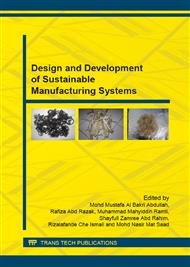[1]
Kovács, Peter, Z. Raida, and Z. Lukes. Design and optimization of periodic structures for simultaneous EBG and AMC operation., In Microwave Techniques (COMITE), 2010 15th International Conference on, pp.195-198. IEEE, (2010).
DOI: 10.1109/comite.2010.5481268
Google Scholar
[2]
N. Wiwatcharagoses, Metamaterial microstrip transmission line based microwave circuits and sensors, 3548786 Ph.D., Michigan State University, Ann Arbor, (2012).
Google Scholar
[3]
Y. Dong and T. Itoh, Metamaterial-based antennas, Proceedings of the IEEE, vol. 100, pp.2271-2285, (2012).
Google Scholar
[4]
M. Maassel, A metamaterial-based multiband phase shifter, North Dakota State University, (2014).
Google Scholar
[5]
A. Marteau, T. Decoopman, M. -F. Foulon, E. Lheurette, and D. Lippens, Metamaterial-based transmission line: The fin line approach, in Microwave Conference, 2005 European, 2005, p.4 pp.
DOI: 10.1109/eumc.2005.1608885
Google Scholar
[6]
B. L. Pham, Metamaterial-inspired and Defected-ground Techniques for High Performance Baluns and Antennas, Univeristy of California, (2014).
Google Scholar
[7]
B. Ijaz, Metamaterial-inspired reconfigurable series-fed arrays, (2014).
Google Scholar
[8]
T. Chen, S. Li, and H. Sun, Metamaterials application in sensing, Sensors, vol. 12, pp.2742-2765, (2012).
Google Scholar
[9]
W. Xu, Metamaterials with Active Circuits, 3563644 Ph.D., Tufts University, Ann Arbor, (2013).
Google Scholar
[10]
G. V. Eleftheriades and N. Engheta, Metamaterials: Fundamentals and Applications in the MicrowaveandOpticalRegimes, Proceedings of the IEEE, vol. 99, (2011).
Google Scholar
[11]
M. Huang and J. Yang, Microwave sensor using metamaterials, Wave Propagation, pp.13-36, (2011).
Google Scholar
[12]
R. Melik, E. Unal, N. K. Perkgoz, B. Santoni, D. Kamstock, C. Puttlitz, et al., Nested metamaterials for wireless strain sensing, Selected Topics in Quantum Electronics, IEEE Journal of, vol. 16, pp.450-458, (2010).
DOI: 10.1109/jstqe.2009.2033391
Google Scholar
[13]
O. Abu Safia, L. Talbi, and K. Hettak, A New Type of Transmission Line-Based Metamaterial Resonator and Its Implementation in Original Applications, Magnetics, IEEE Transactions on, vol. 49, pp.968-973, (2013).
DOI: 10.1109/tmag.2012.2230248
Google Scholar
[14]
T. A. Elwi, Novel Antennas based on Innovations in Nano-Scale and Metamaterial Structures, 3490596 Ph.D., University of Arkansas at Little Rock, Ann Arbor, (2011).
Google Scholar
[15]
C. Pelletti, R. Arya, A. Rashidi, H. Mosallaei, and R. Mittra, Numerical Techniques for Efficient Analysis of FSSs, EBGs and Metamaterials, in Computational Electromagnetics, R. Mittra, Ed., ed: Springer New York, 2014, pp.393-443.
DOI: 10.1007/978-1-4614-4382-7_11
Google Scholar
[16]
L. Wang and J. L. -W. Li, A Novel Metamaterial Microstrip Antenna of Broadband and High-Gain, Proceedings of ISAP2012, vol. 3, p.5, (2012).
Google Scholar
[17]
H. R. Khaleel, Novel metamaterial based antennas for flexible wireless systems, 3509695 Ph.D., University of Arkansas at Little Rock, Ann Arbor, (2012).
Google Scholar
[18]
N. R. Labadie and S. K. Sharma, A novel compact volumetric metamaterial structure with asymmetric transmission and polarization conversion, Metamaterials, vol. 4, pp.44-57, (2010).
DOI: 10.1016/j.metmat.2010.04.003
Google Scholar
[19]
D. H. Werner, J. A. Bossard, Z. Bayraktar, Z. H. Jiang, M. D. Gregory, and P. L. Werner, Nature Inspired Optimization Techniques for Metamaterial Design, in Numerical Methods for Metamaterial Design, ed: Springer, 2013, pp.97-146.
DOI: 10.1007/978-94-007-6664-8_5
Google Scholar
[20]
J. L. Volakis and K. Sertel, Narrowband and wideband metamaterial antennas based on degenerate band edge and magnetic photonic crystals, Proceedings of the IEEE, vol. 99, pp.1732-1745, (2011).
DOI: 10.1109/jproc.2011.2115230
Google Scholar
[21]
C. H. Ahn, Microwave metamaterial applications using complementary split ring resonators and high gain rectifying reflectarray for wireless power transmission, 3436775 Ph.D., Texas A&M University, Ann Arbor, (2010).
Google Scholar
[22]
E. Martini and S. Maci, Metasurface Transformation Theory, in Transformation Electromagnetics and Metamaterials, D. H. Werner and D. -H. Kwon, Eds., ed: Springer London, 2014, pp.83-116.
DOI: 10.1007/978-1-4471-4996-5_3
Google Scholar
[23]
Odabasi, H., and F. L. Teixeira. Electric-field-coupled resonators as metamaterial loadings for waveguide miniaturization., Journal of Applied Physics114, no. 21 (2013): 214901.
DOI: 10.1063/1.4837597
Google Scholar
[24]
Seetharamdoo, Divitha, Ronan Sauleau, Kouroch Mahdjoubi, and Anne-Claude Tarot. Effective parameters of resonant negative refractive index metamaterials: Interpretation and validity., Journal of applied physics 98, no. 6 (2005): 063505.
DOI: 10.1063/1.2041841
Google Scholar
[25]
Polemi, Alessia, Stefano Maci, and P. Kildal. Dispersion characteristics of a metamaterial-based parallel-plate ridge gap waveguide realized by bed of nails., Antennas and Propagation, IEEE Transactions on 59, no. 3 (2011): 904-913.
DOI: 10.1109/tap.2010.2103006
Google Scholar
[26]
Balanis, Constantine A. Antenna theory: analysis and design. John Wiley & Sons, (2012).
Google Scholar
[27]
Studio, CST Microwave. Workflow & solver overview., CST Studio Suite (2008).
Google Scholar
[28]
Xu, He-Xiu, Guang-Ming Wang, Mei-Qing Qi, Chen-Xin Zhang, Jian-Gang Liang, Jian-Qiang Gong, and Yong-Chun Zhou. Analysis and design of two-dimensional resonant-type composite right/left-handed transmission lines with compact gain-enhanced resonant antennas., Antennas and Propagation, IEEE Transactions on 61, no. 2 (2013).
DOI: 10.1109/tap.2012.2215298
Google Scholar
[29]
Li, Bo, and Zhongxiang Shen. Synthesis of quasi-elliptic bandpass frequency-selective surface using cascaded loop arrays., Antennas and Propagation, IEEE Transactions on 61, no. 6 (2013): 3053-3059.
DOI: 10.1109/tap.2013.2250237
Google Scholar
[30]
Romo, G., and A. Ciccomancini Scogna. Substrate integrated waveguide (SIW) filter: Design methodology and performance study., In Signal Integrity and High-Speed Interconnects, 2009. IMWS 2009. IEEE MTT-S International Microwave Workshop Series on, pp.23-26. IEEE, (2009).
DOI: 10.1109/imws.2009.4814901
Google Scholar


